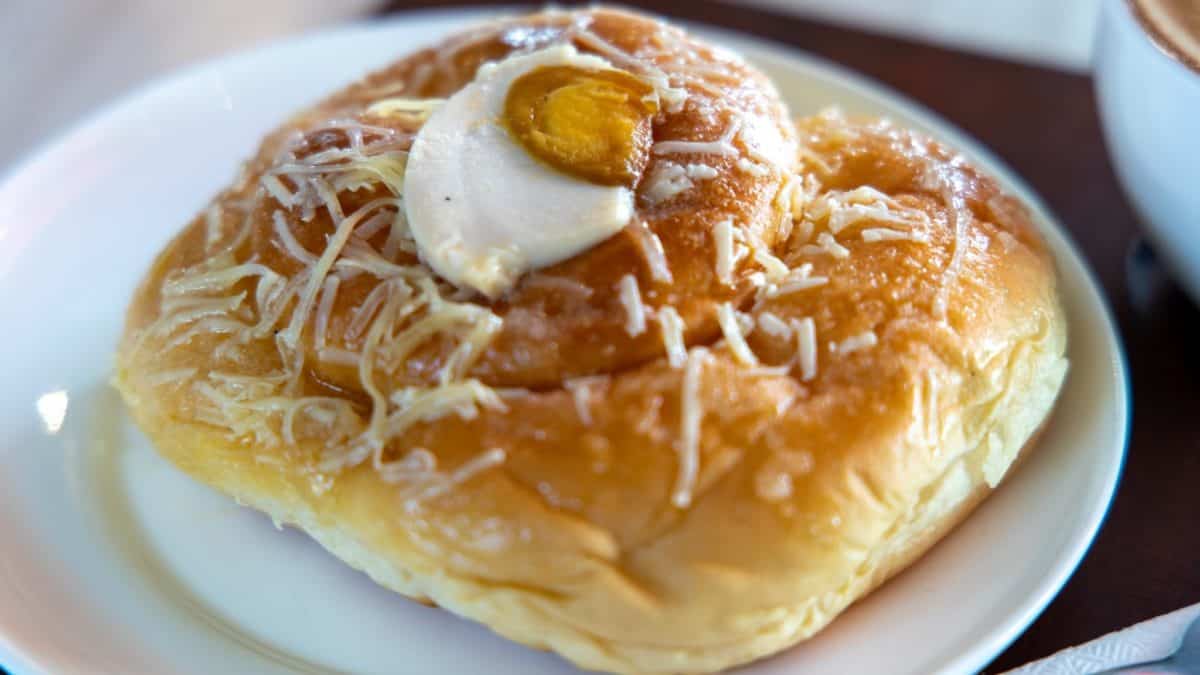Ensaymada: The Filipino Sweet Buns
Ensaïmada is a pastry product from Mallorca, Spain. It is a common cuisine eaten in most former Spanish territories in Latin America and the Philippines adopted it as well, calling it ensaymada with a “y”.
It can be served on big occasions as a take-home food, in meetings as a snack, or even as children’s “baon” for school.
With its filling nature and cheesy texture, this flexible food is a usual fare for Filipino taste buds. The bread is either topped with sugar or cheese and has different varieties, depending on the bakery.


Check out our new cookbook
Bitemybun's family recipes with complete meal planner and recipe guide.
Try it out for free with Kindle Unlimited:
Read for freeIn this post we'll cover:
What is ensaymada?
Filipino-style ensaymada is a type of brioche-like pastry topped with grated cheese, and it is one of the most popular snacks in the Philippines.
The term “ensaymada” is derived from the Spanish word “ensaimada”, which means “floured”.
It is usually served as breakfast or a snack, but it can also be enjoyed as a dessert. Ensaymada is often described as a “sweet cheese roll” because of its combination of sweet and savory flavors.
The dough for ensaymada is usually made with flour, sugar, eggs, and butter. The dough is then proofed (allowed to rise) until it is doubled in size.
After the dough has been proofed, it is then rolled out into a flat sheet. A generous amount of grated cheese is then sprinkled on top of the dough.
The dough is then rolled up into a log, and it is cut into individual pieces. The pieces are then placed on a baking sheet, and they are baked until they are golden brown.
Ensaymada is often served with a hot beverage, such as coffee or tea.
Origin
You’re probably wondering what the history of ensaymada is? As I already mentioned, it was adapted from a Spanish dish.
The Spanish dish is called ensaimada, and it is a type of brioche that originates from the Spanish island of Mallorca.
The first written references to the Majorcan ensaïmada date back to the 17th century.
At that time, although wheat flour was mainly used for making bread, there is evidence that this typical pastry product was made for festivals and celebrations.
The ensaïmada de Mallorca is made with strong flour, water, sugar, eggs, mother dough and a kind of reduced pork lard named saïm.
The handmade character of the product makes it difficult to give an exact formula, so scales have been established defining the proportion of each ingredient, giving rise to an excellent quality traditional product.
The name comes from the Catalan word saïm, which means ‘pork lard’ (from the Arab word shahim, meaning ‘fat’).
In Mallorca and Ibiza there is a sweet called greixonera made with ensaïmada pieces left over from the day before.
Ensaymada was introduced to the Philippines during the colonial period, and it quickly became a popular snack food.
The original ensaymada has a flakier dough and a different texture. In the 18th century, some of the ingredients and preparation methods changed in the Philippines.
The pastry became richer because more egg yolks were added alongside generous portions of lard or butter.
This dish was popular during Holidays like Easter and Christmas because it was a luxurious snack that not everyone could afford.
It’s believed that the best ensaymada was made in Pampanga. Bakers from this region taught their recipes to others and the snack became popular all over the Philippines.
Those buttery ensaimadas that you get in Pampanga are truly unique and this type of bun has Pampangan ancestry.
With a golden yellow interior, tender crumb, and a strong butter flavor slathered on top, this regional variation is usually as large as a saucer.
What makes it even more delicious is that each bun is garnished with grated cheese and sugar. The combination of sweet and salty is amazing!
Nowadays, you can find ensaymada in almost any bakery in the Philippines.
What is the difference between ensaymada and mamon?
Ensaymada is made with a dough mixture, while mamon uses sponge cake batter in the recipe. This produces a much softer and fluffier ensaymada.
Ensaymada vs pandesal
Pandesal used to be saltier, but since then, it has evolved from 1.75% sugar to 18% in most recipes, closer to the flavor profile of ensaymada. Ensaymada is more like a brioche than bread using lard or butter to make it fluffier, and it’s usually topped with sugar or cheese.
Conclusion
Ensaymada is another one of those Spanish-inspired dishes that make up the food culture of the Philippines and is very delicious.
Check out our new cookbook
Bitemybun's family recipes with complete meal planner and recipe guide.
Try it out for free with Kindle Unlimited:
Read for freeJoost Nusselder, the founder of Bite My Bun is a content marketer, dad and loves trying out new food with Japanese food at the heart of his passion, and together with his team he's been creating in-depth blog articles since 2016 to help loyal readers with recipes and cooking tips.
